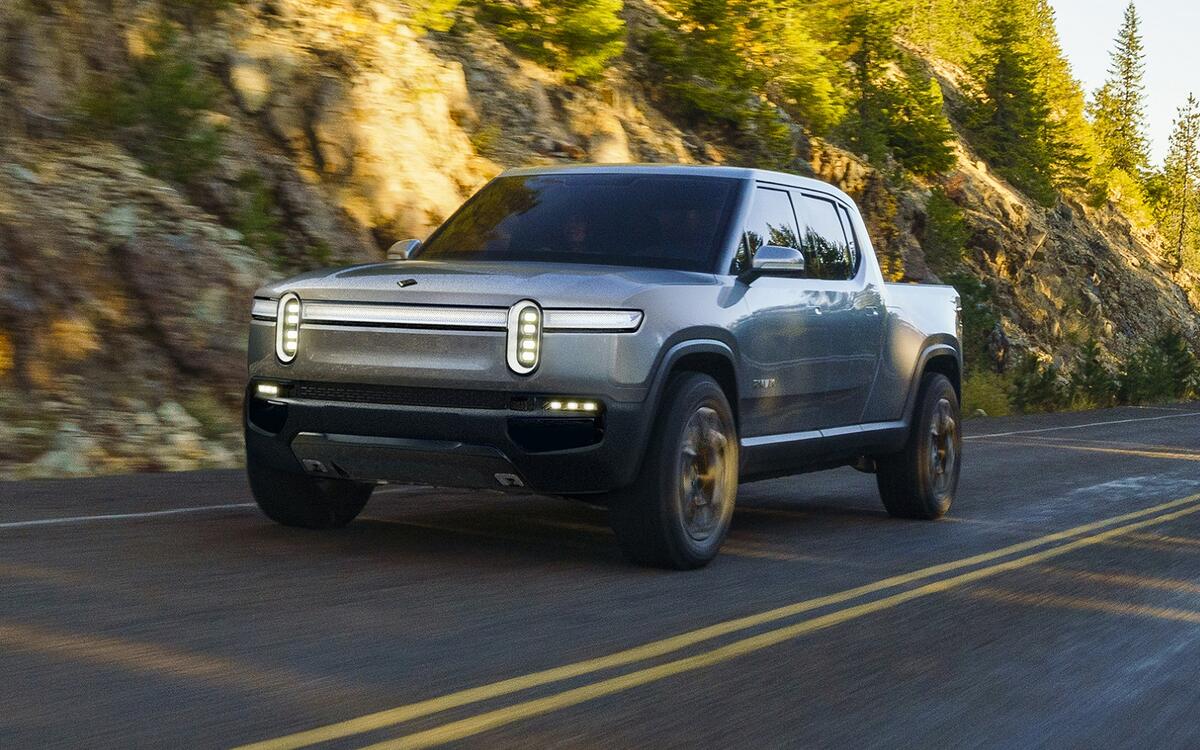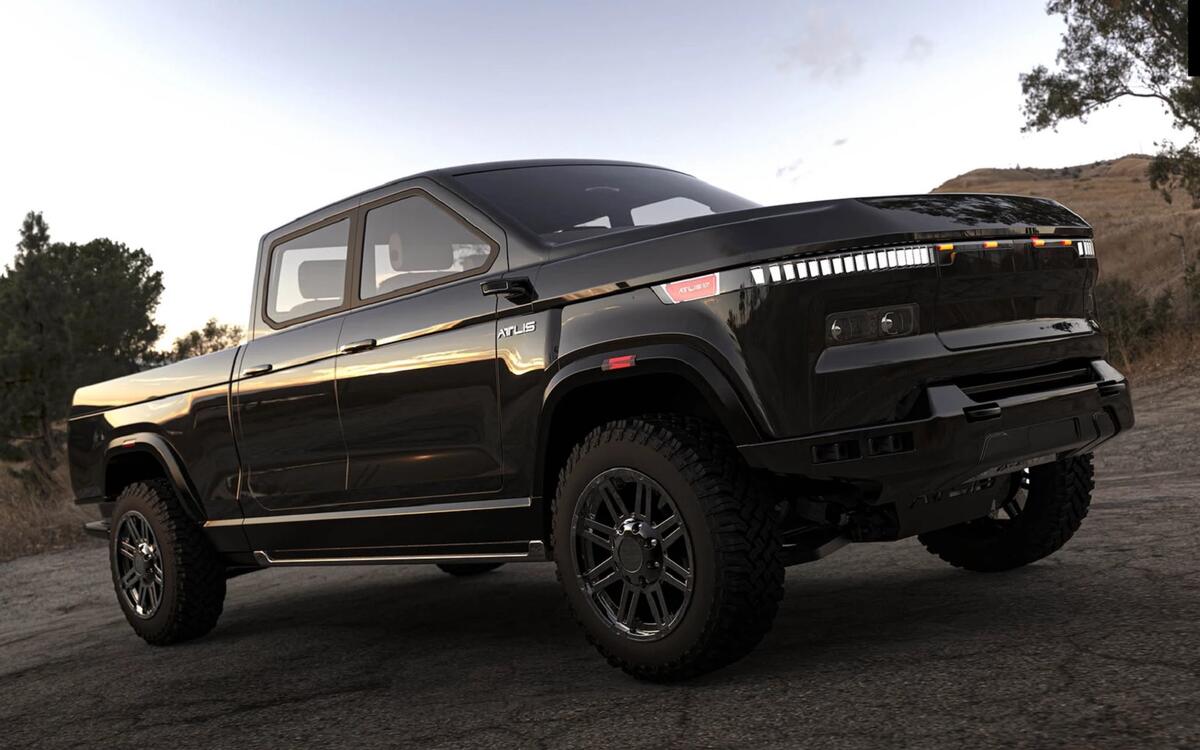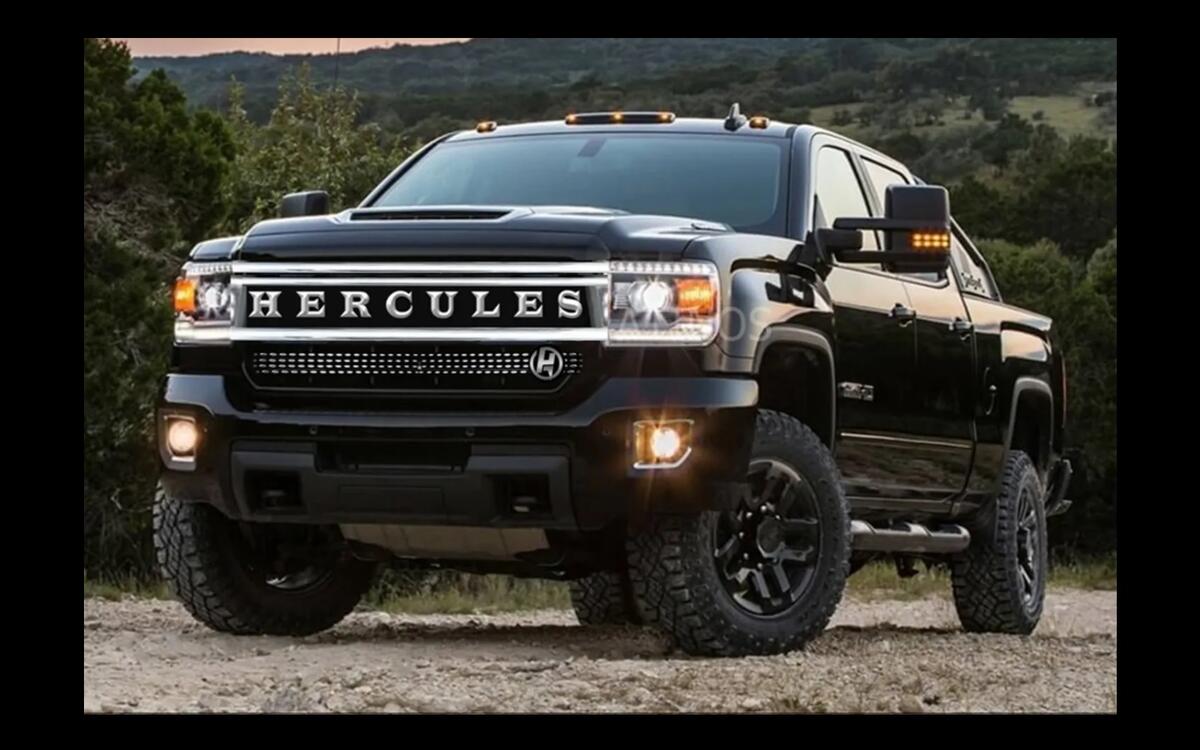 Slide 1 of 21
Slide 1 of 21
After decades of gradual evolution, the pickup truck class is about to undergo a massive revolution.
The number of companies developing electric pickups grows on a monthly basis and all of them promise to deliver a credible alternative to six- and eight-cylinder engines. The epicentre of this uprising is in America, where the three companies that have historically dominated the sales chart (Ford, Chevrolet and Dodge/Ram) are facing competition from tech-driven upstarts like Rivian, Tesla and many others.
Here are the models seeking to end the piston-powered engine’s dominance in the highly lucrative pickup class. It’s important to remember none of these trucks are in production as of now, there is not a single battery-powered pickup available commercially, so the specifications listed and the designs shown could change significantly by the time they reach customers – assuming they make it that far:
 Slide 1 of 21
Slide 1 of 21
Atlis XT (2020)
In 2019, Arizona-based Atlis digitally unveiled a truck with impressive specifications and a design that looks like it was beamed from the 2030s. Called XT, a nameplate we normally associate with a wedge-shaped Subaru, it takes the form of a rather conventionally-proportioned pickup with a list of options that includes two cab sizes, two cargo box sizes plus single or dual rear wheels.
After selecting a body style, buyers will need to configure the drivetrain. Atlis pledged to offer versions with up to 300, 400 and 500 miles of range, respectively. All of them will receive an electric motor per wheel (four total) rather than one per axle, which is the unofficial norm in the electric car world.
 Slide 1 of 21
Slide 1 of 21
Atlis XT (2020)
The Atlis XT will take 5.0sec to reach 60mph from a stop and tow up to 7727kg in its most potent configuration. The start-up also estimated its first production model will last for one million miles. How? We’re still waiting to find out but the answer should be right around the corner.
Atlis boldly announced plans to begin manufacturing the XT in the United States in 2020, though it didn’t reveal where production will take place. Pricing starts at $45,000 (about £35,000) and the company has already started taking reservations. It’s also actively seeking investors to fund the project.
 Slide 1 of 21
Slide 1 of 21
Lordstown Endurance (late 2020)
Lordstown Motors gets its name from the Lordstown, Ohio, factory it purchased from General Motors in 2019, the same year it was founded. That’s where the company plans to build its first model, an electric pickup called Endurance and powered by technology sourced from another start-up named Workhorse. It will start at $52,500 (about £40,800) before tax incentives are factored in.
 Slide 1 of 21
Slide 1 of 21
Lordstown Endurance (late 2020)
The Endurance will receive one electric motor per wheel, a layout which will make it relatively easy to control how much torque gets transferred to each corner. It’s expected to offer about 260 miles of range. Lordstown has already started taking reservations and it plans to build the first examples by the end of 2020. That’s ambitious, but it’s not fully starting from scratch because it has – in theory – a turn-key factory and it plans to re-hire as many of the workers laid off by General Motors as possible.
 Slide 1 of 21
Slide 1 of 21
Rivian R1T (late 2020)
When it comes to electric pickups, many companies spent years talking a great deal but doing little. Rivian stayed off everyone’s radar until it introduced a battery-powered truck named R1T during the 2018 Los Angeles motor show. It’s clearly aimed more at outdoorsy adventurers than utility companies, which partly explains why it will start at $69,000 (about £53,000) before incentives.
The close-to-production concept arrived with a three-box silhouette, a four-door cab and a digital-looking front end characterized by LEDs. It seats five passengers in a cabin that blends natural materials like wood with cutting-edge technology features such as a pair of high-resolution colour screens.
 Slide 1 of 21
Slide 1 of 21
Rivian R1T (late 2020)
230-, 300- and 400-mile range versions of the R1T will be available. The quickest takes 3.0sec to reach 60mph from a stop, a figure normally claimed by supercar manufacturers, and users will be able tow up to 5000kg. An electric motor mounted behind each wheel will deliver through-the-road permanent all-wheel drive while increasing the truck’s off-road prowess.
Rivian plans to start building the R1T and an SUV named R1S in a former Mitsubishi factory located in Normal, Illinois, by the end of 2020. The company is new to the world of automotive manufacturing but it has attracted big-name investors like Ford and Amazon so it has the funds to ramp up production.
 Slide 1 of 21
Slide 1 of 21
Bollinger B2 (2021)
Like many start-up automakers, Bollinger is making striking claims as it transforms its first model from a concept to a production car. It declared the electric B2 will be the world’s most capable truck when deliveries start in 2021. It has a 3409kg towing capacity and a 200-mile driving range, neither of which are particularly impressive, though its dual-motor, 606bhp drivetrain allows it to haul 2273kg.
 Slide 1 of 21
Slide 1 of 21
Bollinger B2 (2021)
The B2’s specifications are middling at best but it looks like it will be one of the cleverest trucks in its segment. Part of the Land Rover Defender-like front end folds down to reveal a 5791mm tunnel carved out to let owners carry annoyingly long items like timber and plumbing pipes. It will also come with 10 power outlets that will draw juice from the battery to run power tools or charge a phone far off the grid.
Bollinger’s B2 carries a base price of $125,000 (about £97,000) before incentives. The truck will be made by hand alongside an SUV named B1 that’s built on the same architecture.
 Slide 1 of 21
Slide 1 of 21
Ford F-150 Electric (late 2021)
Ford’s electrification strategy somewhat surprisingly includes hybrid and electric variants of the F-150. The F-Series family of models (which includes the F-150 as well as bigger trucks like the F-350) has ruled America’s sales chart for 42 consecutive years and the company is ready to tussle to stay on top.
Both models will be based on the next generation of the truck due out in the early 2020s. The hybrid will come first, Ford confirmed we’ll see it before the end of 2020, while the battery-powered model might not join the Mustang Mach-E in showrooms until the end of 2021.
 Slide 1 of 21
Slide 1 of 21
Ford F-150 Electric (late 2021)
Ford has already started testing electric F-150 prototypes but technical specifications – including its powertrain layout and its range – remain under wraps. It released a video showing one of its test mules towing 10 double-decker rail cars carrying 42 new 2019 F-150s, a load which weighs more than 454,000kg. Of course, a stunt doesn’t guarantee healthy sales, so we’ll wait until the model makes its debut to see how it stacks up against the competition and how it’s received by truck buyers.
Current F-150 owners who aren’t interested in electric trucks don’t need to worry yet. The next-generation model’s powertrain palette will again include several gasoline-burning options.
 Slide 1 of 21
Slide 1 of 21
General Motors (Autumn 2021)
General Motors CEO Mary Barra confirmed the group will release an electric pickup in the autum of 2021. “It will be a very capable truck; I’m pretty excited about it,” she told investors in 2019.
The company hasn’t revealed which one of its brands will launch the truck, let alone what it will look like, how far it will be able to drive on a charge or how much it will be capable of towing. Production will take place on the outskirts of Detroit in the Hamtramck factory General Motors nearly closed. PICTURE: 2020 Chevrolet Silverado
 Slide 1 of 21
Slide 1 of 21
General Motors (Autumn 2021)
While this isn’t official, sources close to General Motors hinted the group will launch several electric pickup trucks and SUVs during the 2020s. It’s reasonable to speculate they’ll join the Chevrolet and GMC line-ups but insiders revealed resurrecting the Hummer brand is still on the table. This strategy would allow General Motors to give Chevrolet and GMC more traditional models (e.g., a standard Silverado with a battery-powered drivetrain) while allocating more lifestyle-oriented, off-road-ready trucks and SUVs to Hummer, which was shut down in 2010 after executives failed to sell it to the Chinese.
Cadillac won’t return to the pickup class but the components General Motors is developing for its electric trucks will power a battery-powered version of the next-generation Escalade. PICTURE: Hummer H2 SUT
 Slide 1 of 21
Slide 1 of 21
Hercules Alpha (2021)
Detroit-based Hercules was co-founded by James Breyer, an engineer who worked on Chevrolet’s Volt and Bolt models, among other electrified cars. The company’s mission statement states it’s out to build nothing less than the best pickup truck on the planet. Named Alpha, its first model will arrive with four electric motors that join forces to deliver 1000bhp and a 5682kg towing capacity. Hercules hasn’t published details about the battery pack it plans to use but it claims a 300-mile range.
We don’t know what the Alpha will look like yet. All we’ve seen so far is an image of a GMC Sierra HD All-Terrain X with a crudely Photoshopped new-look front end (pictured). Hercules will unveil the truck in the spring of 2020 and it plans to start production in 2021.
 Slide 1 of 21
Slide 1 of 21
Tesla Cybertruck (late 2021)
Tesla went above and beyond in its attempt to make the Cybertruck look like nothing else on the road. We’ll let you decide whether or not that’s a good thing. While you deliberate, keep in mind it’s about the same size as a Ford F-150 but it will only be available with four doors, one cargo box size and a six-seater cabin.
The minimalist interior layout seen on the Model 3 gets cranked up a notch in the truck thanks to a giant, 17in touchscreen that displays the infotainment system.
 Slide 1 of 21
Slide 1 of 21
Tesla Cybertruck (late 2021)
Tesla plans to offer three Cybertruck variants. The entry-level model gets rear-wheel drive, up to 250 miles of range and a $39,000 (about £30,000) base price. The all-wheel drive, dual-motor mid-range model costs $49,000 (around £38,000) and offers up to 300 miles of range while the full-fat variant gains a third electric motor to reach 0-60mph in 2.9sec. It can drive for up to 500 miles between charges, it can tow up to 14,000lb and it could be yours in exchange for $69,000 (approximately £53,000).
The company has started accepting reservations and Cybertruck production is scheduled to begin in late 2021. Keep in mind Tesla and deadlines don’t normally go hand in hand, however.
 Slide 1 of 21
Slide 1 of 21
Neuron T.One
Neuron is a start-up automaker founded in 2017 and based in Los Angeles, though it claims to work with American and Asian partners. This little-known company introduced a concept named T.One at the 2019 China International Import Expo (CIIE) held in Shanghai. The concept takes the form of a futuristic-looking pickup that stands out with a short front end and an unusually spacious cab.
Without providing technical specifications, or even a release date, Neuron explained it envisions a range of three T.One-based models. In addition to the pickup, the company plans to release a cab-chassis that can be fitted with a fifth-wheel hitch and a cargo-hauling van. They will all ride on the same platform.
 Slide 1 of 21
Slide 1 of 21
Neuron T.One
The T.One’s interior is unusual because it places the driver front and centre, McLaren F1-style, though Neuron will also offer four-, five- and six-seater configurations. Regardless, the passengers travel on individual, almost business class-like chairs which look like they offer a level of comfort not commonly found in the pickup segment.
But while anyone can commission attractive computer-generated images, turning them into a running and driving truck requires a tremendous amount of skill and capital. We’ll need to be patient to find out whether Neuron can pull it off and when we can get behind the wheel.
 Slide 1 of 21
Slide 1 of 21
What about hybrids?
The upcoming wave of electric pickup trucks is gathering a tremendous amount of attention but automakers are also working on other ways to electrify the segment. Ram already offers the 1500 with a mild hybrid system and Ford’s aforementioned F-150 hybrid will enter the fray by the end of 2020.
Toyota has remained surprisingly quiet but rumours claim it’s developing a petrol-electric drivetrain built around a twin-turbocharged V6 engine for the next-generation Tundra due out in 2020. PICTURE: 2019 Toyota Tundra
 Slide 1 of 21
Slide 1 of 21
Blast from the past: Chevrolet S-10 Electric (1997-1998)
America is the largest pickup market in the world and the folks who buy trucks have historically been on the opposite end of the spectrum from the motorists who care deeply about fuel economy. That’s why six-, eight- and sometimes 10-cylinder engines have dominated the segment for decades. That didn’t stop Chevrolet from using bits and pieces of the General Motors EV1 to electrify the S-10 pickup.
The S-10 Electric was aimed largely at utility companies when it made its debut in 1997 with a lead-acid battery pack that provided about 50 miles of range at a leisurely pace. The following year, Chevrolet bumped driving range to 90 miles and made the S-10 quicker by fitting it with a nickel-metal hybride battery. About 492 units were made in 1997 and 1998 and approximately 440 of them were leased to customers; most of these were destroyed at the end of their life cycle. The remaining examples were sold to private parties, so their owner decided their fate, but they’re a rare sight in 2019.
 Slide 1 of 21
Slide 1 of 21
Blast from the past: Ford Ranger EV (1997-2002)
Ford experimented with an electric version of the Ranger between 1997 and 2002. Like rival Chevrolet, it leased a majority of the production run to fleets across America and sold a small handful to early adopters. The Ranger EV illustrates how far electric technology has advanced since the late 1990s. It had 82 miles of range in normal driving conditions and it was unspeakably slow; hitting 50mph took 10.3sec and it stopped accelerating when it reached about 75mph.
Tesla’s striking new Cybertruck is grabbing all the attention, but it’s just one of a fleet of electric pickups heading our way
Advertisement













































